The Yellow-Crowned Woodpecker, a member of the Picidae family, is a remarkable bird species often overlooked despite its fascinating characteristics.
Found primarily in subtropical or tropical moist lowland forests, these birds boast striking plumage of vibrant yellow and black, captivating observers with their beauty.
Beyond their aesthetic appeal, Yellow-Crowned Woodpeckers play a crucial role in ecosystem health by controlling insect populations and contributing to the symphony of natural sounds with their unique drumming calls.
What truly distinguishes them, however, is their nesting behavior. With their sharp beaks, they skillfully carve out nests in dead tree trunks—a testament to their strength and precision.
Their clever habit of recycling old nests showcases their intelligence and efficiency, making them a species deserving admiration and attention.
Habitat and Distribution of the Yellow-Crowned Woodpecker
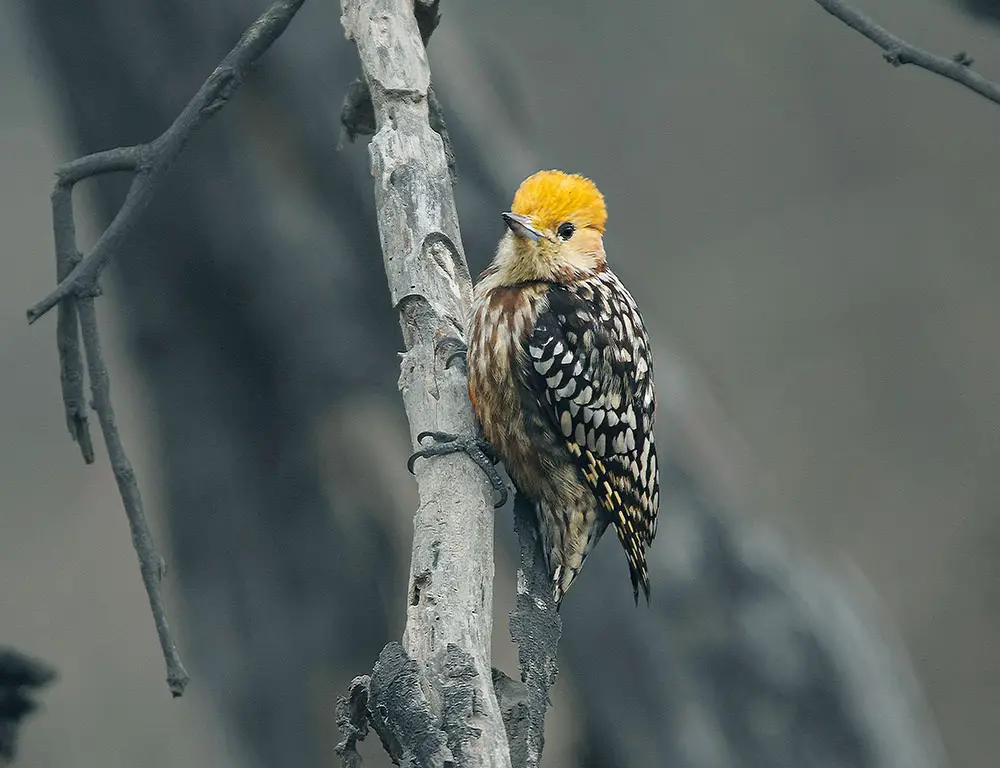
The Yellow-Crowned Woodpecker, a tropical bird species native to Asia, thrives in various habitats across the continent.
Here’s a detailed exploration of its habitat and distribution:
Habitat
These woodpeckers are predominantly found in broadleaf forests, where they find ample shelter and food resources. They prefer trees such as teak and sal, which are common in their habitats.
The dense foliage of these forests provides suitable cover and harbors a diverse array of insects, which form a significant part of their diet.
Distribution
The range of the Yellow-Crowned Woodpecker extends across several countries in South Asia:
- India: They inhabit regions from the Western Ghats to the central and eastern parts of the country. These areas offer a mix of forested landscapes that suit their habitat requirements.
- Nepal: Yellow-crowned woodpeckers are found in the Terai lowland areas, where they inhabit the lush forests that characterize this region.
- Bangladesh: They are notably present in the Sundarbans mangrove forest, where dense vegetation and water bodies provide an ideal habitat.
- Occasional Sightings: While their primary range includes India, Nepal, and Bangladesh, occasional sightings have been reported from Sri Lanka, indicating some dispersal beyond their core distribution areas.
Altitudinal Range
One notable aspect of their distribution is their adaptability to different elevations. Yellow-crowned woodpeckers can be found at altitudes ranging from sea level to approximately 1300 meters above sea level.
This versatility allows them to inhabit various habitats, from lowland forests to moderately elevated terrains.
Local Movements
While they are not migratory birds, Yellow-Crowned Woodpeckers may exhibit local movements within their range. These movements are often influenced by fluctuations in food availability or nesting conditions within their preferred habitats.
Physical Characteristics of the Yellow-Crowned Woodpecker
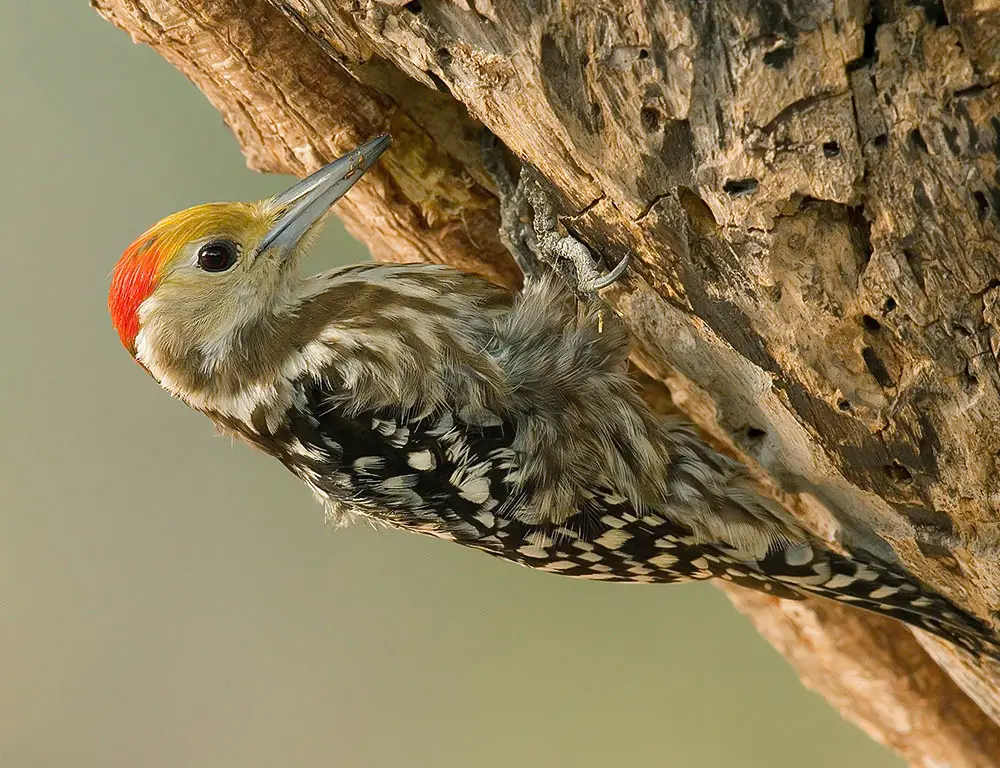
When I first laid eyes on the yellow-crowned woodpecker, the bird’s striking colors gave The Yellow-Crowned Woodpecker a striking appearance and a set of physical features uniquely adapted to its life in the wild.
Here’s a detailed breakdown of its physical characteristics:
Crown (Male)
The male Yellow-Crowned Woodpecker sports a vivid yellow crown and nape, creating a bold contrast against its black forehead and throat. This distinctive coloring makes it easily identifiable.
Crown (Female)
In contrast, the female’s crown is a more subdued olive-yellow color, lacking the vibrant hue of the male. It has no distinct border and blends more seamlessly with the rest of the plumage.
Body Color
Both genders feature a predominantly green body, which serves as effective camouflage in their forest habitat. This green plumage helps them blend into the foliage, making them less conspicuous to predators and prey.
Size
The Yellow-Crowned Woodpecker is medium-sized for its species, measuring 28-30 cm long from tip to tail. Its wingspan can reach up to 52 cm in width, providing ample surface area for efficient flight.
Despite their compact body shape, they are robust birds with a substantial physical presence.
Beak & Feet
Equipped with a solid chisel-like beak, Yellow-Crowned Woodpeckers are adept at boring into tree trunks for food. Their zygodactyl feet, with two toes pointing forward and two backward, provide exceptional grip and balance when scaling vertical tree trunks.
These adaptations make them well-suited for their arboreal lifestyle and foraging behavior.
Diet and Feeding Habits of the Yellow-Crowned Woodpecker
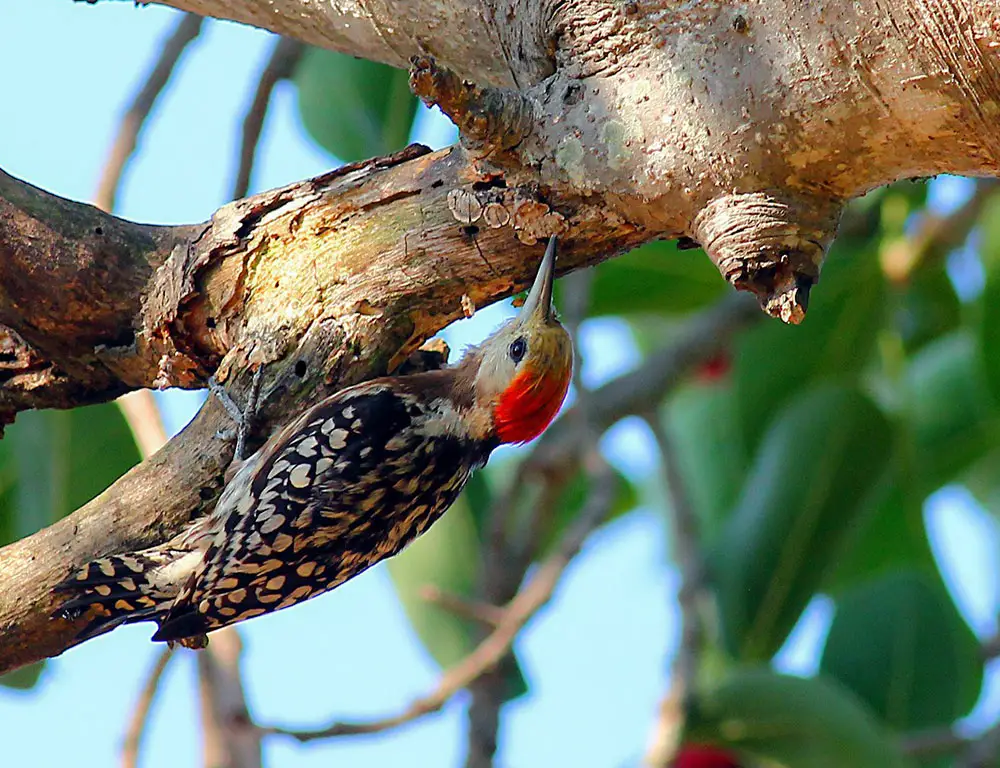
The diet and feeding habits of the Yellow-Crowned Woodpecker are diverse and adaptable, reflecting their ability to thrive in various environments.
Here’s a breakdown of their diet and feeding behavior:
Primary Diet
Yellow-crowned woodpeckers are primarily insectivores, with insects constituting around 70% of their diet. They feed on insects, including beetles, ants, and other arthropods, which they dislodge from tree bark using their strong beaks.
Feeding Technique
Their distinctive drumming or pecking behavior helps them locate and extract insects from within tree bark. This behavior is not only effective in finding food but is also unique to woodpeckers.
Secondary Diet
Fruits and berries also form a significant part of their diet, contributing approximately 15%. These provide essential vitamins and sugars, supplementing their insect intake.
Seasonal Variation
Yellow-crowned woodpeckers adjust their diet according to seasonal changes. During winter, when insects are scarce, they rely more heavily on plant-based foods such as seeds and nuts, which comprise about 10% of their diet.
Adaptability
Despite their preference for insects, Yellow-Crowned Woodpeckers demonstrate adaptability by incorporating various foods into their diet based on availability. This adaptability contributes to their resilience in the wild.
Let me provide you with some numbers:
| Food Source | Percentage |
|---|---|
| Insects | 70% |
| Fruits | 15% |
| Seeds | 10% |
| Other | 5% |
Reproduction and Nesting Behavior of the Yellow-Crowned Woodpecker
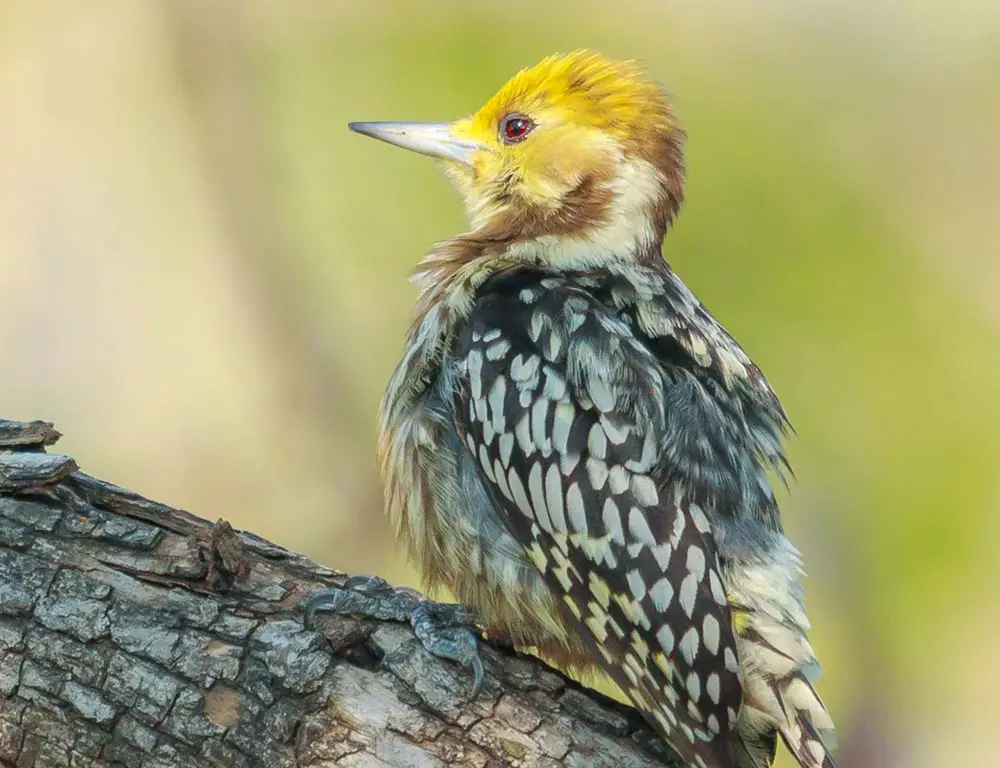
The Yellow-Crowned Woodpecker’s reproductive cycle and nesting behavior offer a captivating glimpse into the intricacies of avian life.
Here’s a closer look at their journey to ensure the continuation of their species:
Monogamy
Yellow-crowned woodpeckers are monogamous birds, forming lifelong bonds with their chosen partners. This commitment ensures stability and cooperation in their breeding efforts.
Breeding Season
Mating typically occurs between March and July, coinciding with abundant food sources that support the demanding reproductive process.
Courtship Rituals
During courtship, the male woos the female through unique displays, including drumming on tree trunks or branches—a melodious love song in the forest canopy.
Nesting Habits
Both parents collaborate in creating a safe nest environment for their offspring. They excavate nest cavities in dead trees or posts, strategically locating them 10-25 feet above ground to minimize predation risks.
Egg Laying and Incubation
The female lays three to five white eggs, diligently incubated by both parents for approximately 12 days. This shared incubation duty underscores the cooperative nature of their parenting.
Parental Care
Upon hatching, the chicks remain under the attentive care of both parents for up to three weeks. They are nourished with a diet primarily of insects brought to the nest by their dedicated caregivers.
Fledgling Stage
After three weeks, the young woodpeckers fled from the nest, beginning their independent journey into the wild. This crucial stage ensures the continuation of their species and the perpetuation of their genetic lineage.
Conservation Status of the Yellow-Crowned Woodpecker
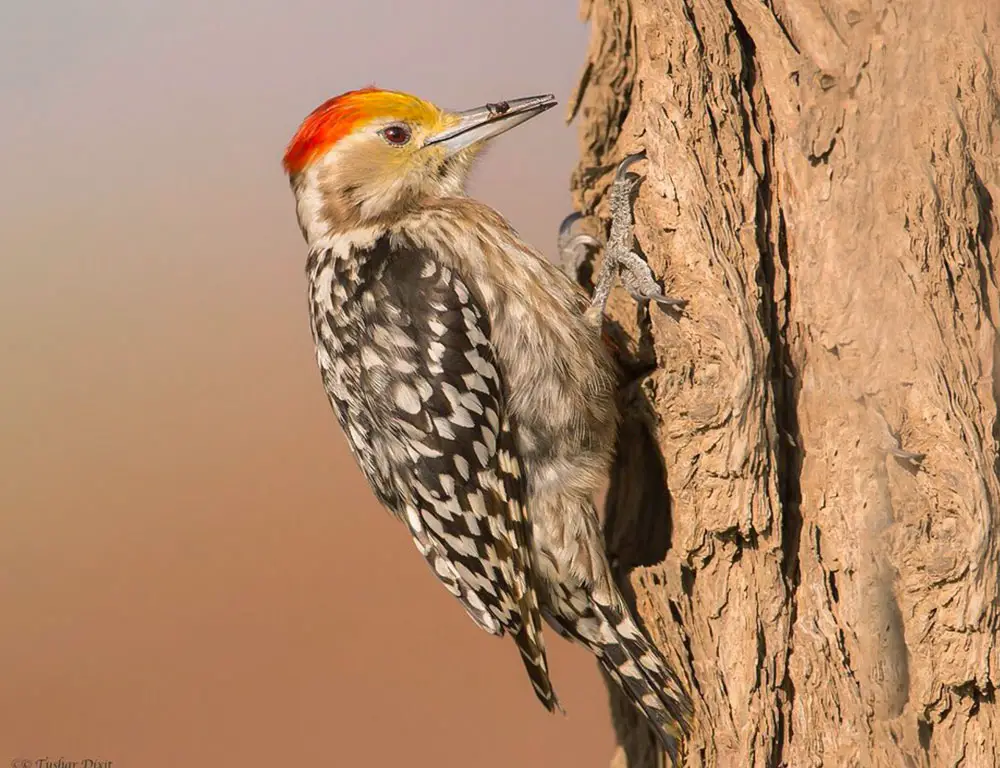
The conservation status of the Yellow-Crowned Woodpecker, as assessed by the International Union for Conservation of Nature (IUCN), is categorized as “Least Concern.”
While this designation indicates that the species is not currently facing immediate threats of extinction, it’s essential to recognize that this status doesn’t warrant complacency regarding their conservation needs.
Population Status
The Yellow-Crowned Woodpecker maintains a robust population across its extensive range, from India to Southeast Asia and Indonesia.
Their adaptability to various habitats, including evergreen forests and plantations, contributes to their widespread distribution and population stability.
Potential Threats
Despite their adaptability, the species faces ongoing threats, primarily habitat destruction and localized hunting.
Habitat loss due to deforestation and land conversion poses a significant risk to their long-term survival, as it diminishes available nesting sites and food resources.
Localized hunting for the pet trade or traditional rituals in certain regions further exacerbates conservation concerns.
Conservation Efforts
Conservation efforts are essential to mitigate these threats and safeguard the Yellow-Crowned Woodpecker’s future.
These may include habitat protection and restoration initiatives, community engagement and education programs to address unsustainable hunting practices, and research better to understand the species’ ecological requirements and population dynamics.
Conclusion
The yellow-crowned Woodpecker captivates with its vibrant plumage and intriguing behaviors, offering valuable insights into the dynamics of our ecosystems. As pest controllers and cavity creators, they play a crucial role in maintaining ecological balance.
Yet, habitat loss threatens their existence. To safeguard these magnificent birds, advocating for forest conservation, planting native trees, and supporting legislation protecting wildlife habitats are vital steps.
No matter how small, every action contributes to preserving nature’s beauty and ensuring the survival of remarkable species like the Yellow-Crowned Woodpecker. Let’s unite in our efforts to protect and cherish the rich biodiversity that surrounds us.